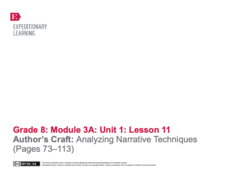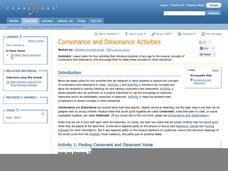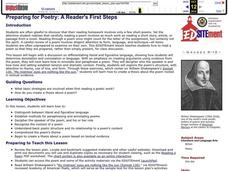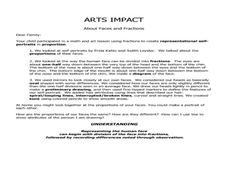Curated OER
Journeying to Create
Show a video clip that descripes how taking a journey can change a person's outlook on life. Learners write a paragraph about a place that uses imagery and tone to create a specfic effect. They evaluate their journal entries as well.
Southern Nevada Regional Professional Development Program
Reading Literature - An Occurrence at Owl Creek Bridge
“An Occurrence at Owl Creek Bridge,” Ambrose Bierce’s short story, is used to model how structural moves, the decisions an author makes about setting, point of view, time order, etc., can be examined to reveal an author’s purpose. Groups...
Curated OER
Energy Transfer in Musical Instruments
Students create unique sounds using different instruments. In this energy lesson, students read and define several vocabulary terms such as heat, energy transfer and thermal equilibrium. Students utilize several household objects to...
EngageNY
Grade 9 ELA Module 1, Unit 1, Lesson 8
You can often track a character's development based on others' reactions to their words or actions. Using Karen Russell's "St. Lucy's Home for Girls Raised by Wolves," ninth graders work in a jigsaw activity to analyze how Mirabella's...
EngageNY
Grade 9 ELA Module 1, Unit 1, Lesson 9
Find the central idea in an excerpt from Karen Russell's "St. Lucy's Home for Girls Raised by Wolves" with a literary analysis lesson. As your class analyzes a section of the story, they determine how the author forms the central idea...
EngageNY
Grade 9 ELA Module 1, Unit 1, Lesson 3
Just like in real life, characters in short stories show their true personalities through their words and deeds. Decipher the character development in Karen Russell's "St. Lucy's Home for Girls Raised by Wolves" with a set of activities...
Brigham Young University
Understanding Design, Composition, and Color
The set for a play combines design elements (style, line, shape, mass, measure, position, color, and texture) and principles of composition (unity, harmony, contrast, variation, balance, proportion, and emphasis) to create a particular...
EngageNY
Author’s Craft: Analyzing Narrative Techniques (Pages 73–113)
Scholars discuss a reading selection in Unbroken by writing to a partner about text selection. After completing the writing, learners revisit the use of active and passive sentences by reviewing a second Active and Passive Sentences...
Curated OER
Energetic Musical Instruments
Students apply the principles and concepts associated with energy and the transfer of energy in an engineering context through the designing and making of a musical instrument. After the accomplishment of the design, students must...
Virginia Department of Education
Developing an Essay: Word Choice
Grading essays after reading a novel written by a lyrical master (think Nabokov, Morrison, Chabon) is a deflating experience. Why can’t your student’s display the same skill in diction as your favorite writers? Because you did not use...
Curated OER
"The 1,000,000 Pound Bank Note" by Mark Twain
Compare real events from Mark Twain's life to events in the story. Middle school readers identify point-of-view, its purpose, and its reliability by citing two examples. They describe the tone of the story using four examples and...
Curated OER
Consonance and Dissonance Activities
Hone those musical ears to identify consonance and dissonance in music being played live or on a recording. Learners will work through four activities where they will listen to consonant and dissonant notes being played first by the...
Curated OER
"You're Probably Tired, Dear Diary" - Children's Diaries during the Holocaust
As part of the study of WWII and the Holocaust, class members read a series of diary entries written by children during the onslaught of Nazi occupation. Each entry is accompanied by biographical information and discussion questions. The...
EngageNY
Figurative Language and Word Choice: A Closer Look at Bud, Not Buddy (Chapter 2)
The difference between an average and an unforgettable writing can lie in the author's word choice. The figurative language in Chapter 2 of Christopher Paul Curtis's Newbery Medal Winner, Bud, Not Buddy, is the focus of a series of...
National Endowment for the Humanities
Jacob Lawrence's Migration Series: Removing the Mask
Describe, analyze, compare and contrast poets from the Harlem Renaissance. Critical thinkers analyze the imagery, characterization, tone, symbolism, and historical context of Jacob Lawrence, Helene Johnson, and Paul Laurence Dunbar. A...
Utah Education Network (UEN)
Boxing and Analysis
Model for your high schoolers how to prepare for the essay portion of the AP Literature exam. For guided practice, pairs analyze metaphor, simile, tone or syntax in Norman Mailer’s “The Death of Benny Paret,” and then work independently...
Curated OER
Water Fitness
Toward the end of the school year when the weather warms up, take your high schoolers swimming! They perform various cardiovascular activities in the pool, beginning with a warm-up activity and followed by stretching, precardio,...
Curated OER
Shaping the View: Symmetry and Balance
Students explore the symmetry and balance in the composition of a variety of art works and note how the viewer's eye is guided to the important components of the image. How these elements affect the tone of the painting and communicate...
Curated OER
Preparing for Poetry: A Reader's First Steps
Students examine denotation and connotation in language, and paraphrase a poem. They read and analyze a sonnet by iam Shakespeare, analyze the attitude and tone, paraphrase a poem, and create a thesis about a poem based on textual evidence.
Curated OER
About Faces and Fractions
Third graders review concepts of fractions, and one-half. They discuss self portraits and the relationships of eyes, nose and mouth to the whole face. Students create base-line self-portraits. On the second day, 3rd graders observe and...
Curated OER
Watch the Road Signs
What makes a good speaker? Upper elementary learners practice oral fluency by working with a partner to read nonfiction books. While reading, they practice using correct tone of voice, making eye contact, and speaking clearly.
Virginia Department of Education
Determining Purpose and Audience
Build the writing skills of your junior high wordsmiths with activities that introduce many essential skills of writing. As a class, they develop working definitions of formal vs. informal writing, explore different categories of...
Virginia Department of Education
Identifying Audience and Purpose
Use a fun and creative activity to introduce junior high learners to how writing changes for different audiences and purposes. The activity begins with a reading by the instructor where teens visualize a food fight in the cafeteria. In...
Let's Drum!
Let's Drum!
Here's a group of exercises designed to introduce a group or class to the rhythm, as well as the basic sounds of a drum, bass and tone. Individuals investigate different types of drums and form drum circles to practice traditional rhythms.
Other popular searches
- Mood and Tone
- Mood and Tone Worksheet
- Tone Mood
- Teaching Mood and Tone
- Author's Tone and Mood
- Analyzing Tone and Mood
- Author's Tone
- Tone and Mood Powerpoint
- Frost Poetry Tone
- Literary Elements Tone
- Voice, Tone, Audience
- Tone of Voice

























